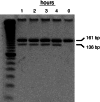Phylogenetic comparisons suggest that distance from the locus control region guides developmental expression of primate beta-type globin genes
- PMID: 16488971
- PMCID: PMC1413942
- DOI: 10.1073/pnas.0511347103
Phylogenetic comparisons suggest that distance from the locus control region guides developmental expression of primate beta-type globin genes
Abstract
Phylogenetic inferences drawn from comparative data on mammalian beta-globin gene clusters indicate that the ancestral primate cluster contained a locus control region (LCR) and five paralogously related beta-type globin loci (5'-LCR-epsilon-gamma-psieta-delta-beta-3'), with epsilon and gamma expressed solely during embryonic life. A gamma locus tandem duplication (5'-gamma(1)-gamma(2)-3') triggered gamma's evolution toward fetal expression but by a different trajectory in platyrrhines (New World monkeys) than in catarrhines (Old World monkeys and apes, including humans). In platyrrhine (e.g., Cebus) fetuses, gamma(1) at the ancestral distance from epsilon is down-regulated, whereas gamma(2) at increased distance is up-regulated. Catarrhine gamma(1) and gamma(2) acquired longer distances from epsilon (14 and 19 kb, respectively), and both are up-regulated throughout fetal life with gamma(1)'s expression predominating over gamma(2)'s. On enlarging the platyrrhine expression data, we find Aotus gamma is embryonic, Alouatta gamma is inactive at term, and in Callithrix, gamma(1) is down-regulated fetally, whereas gamma(2) is up-regulated. Of eight mammalian taxa now represented per taxon by embryonic, fetal, and postnatal beta-type globin gene expression data, four taxa are primates, and data for three of these primates are from this laboratory. Our results support a model in which a short distance (<10 kb) between epsilon and the adjacent gamma is a plesiomorphic character that allows the LCR to drive embryonic expression of both genes, whereas a longer distance (>10 kb) impedes embryonic activation of the downstream gene.
Conflict of interest statement
Conflict of interest statement: No conflicts declared.
Figures


Similar articles
-
Model for the fetal recruitment of simian gamma-globin genes based on findings from two New World monkeys Cebus apella and Callithrix jacchus (Platyrrhini, Primates).J Exp Zool. 1999 Apr 15;285(1):27-40. J Exp Zool. 1999. PMID: 10327648
-
Fetal globin expression in New World monkeys.J Biol Chem. 1996 Jun 21;271(25):14684-91. doi: 10.1074/jbc.271.25.14684. J Biol Chem. 1996. PMID: 8663037
-
Dynamics of regulatory evolution in primate beta-globin gene clusters: cis-mediated acquisition of simian gamma fetal expression patterns.Gene. 1997 Dec 31;205(1-2):47-57. doi: 10.1016/s0378-1119(97)00476-9. Gene. 1997. PMID: 9461379
-
Globin gene switching in primates.Comp Biochem Physiol A Mol Integr Physiol. 2002 Nov;133(3):877-83. doi: 10.1016/s1095-6433(02)00205-2. Comp Biochem Physiol A Mol Integr Physiol. 2002. PMID: 12443943 Review.
-
Chromatin structure and control of beta-like globin gene switching.Exp Biol Med (Maywood). 2002 Oct;227(9):683-700. doi: 10.1177/153537020222700902. Exp Biol Med (Maywood). 2002. PMID: 12324650 Review.
Cited by
-
Differential loss of embryonic globin genes during the radiation of placental mammals.Proc Natl Acad Sci U S A. 2008 Sep 2;105(35):12950-5. doi: 10.1073/pnas.0804392105. Epub 2008 Aug 28. Proc Natl Acad Sci U S A. 2008. PMID: 18755893 Free PMC article.
-
Mobile DNA and the TE-Thrust hypothesis: supporting evidence from the primates.Mob DNA. 2011 May 31;2(1):8. doi: 10.1186/1759-8753-2-8. Mob DNA. 2011. PMID: 21627776 Free PMC article.
-
Developmental and species-divergent globin switching are driven by BCL11A.Nature. 2009 Aug 27;460(7259):1093-7. doi: 10.1038/nature08243. Epub 2009 Aug 5. Nature. 2009. PMID: 19657335 Free PMC article.
-
New genes as drivers of phenotypic evolution.Nat Rev Genet. 2013 Sep;14(9):645-60. doi: 10.1038/nrg3521. Nat Rev Genet. 2013. PMID: 23949544 Free PMC article. Review.
-
Genomic evidence for independent origins of beta-like globin genes in monotremes and therian mammals.Proc Natl Acad Sci U S A. 2008 Feb 5;105(5):1590-5. doi: 10.1073/pnas.0710531105. Epub 2008 Jan 23. Proc Natl Acad Sci U S A. 2008. PMID: 18216242 Free PMC article.
References
-
- Bunn H. F., Forget B. G. Hemoglobin: Molecular, Genetic, and Clinical Aspects. Philadelphia: Saunders; 1986.
-
- Collins F. S., Weissman S. M. Prog. Nucleic Acid Res. Mol. Biol. 1984;31:315–462. - PubMed
-
- Fraser P., Pruzina S., Antoniou M., Grosveld F. Genes Dev. 1993;7:106–113. - PubMed
-
- Grosveld F., van Assendelft G. B., Greaves D. R., Kollias G. Cell. 1987;51:975–985. - PubMed
-
- Hardison R., Slightom J. L., Gumucio D. L., Goodman M., Stojanovic N., Miller W. Gene. 1997;205:73–94. - PubMed
Publication types
MeSH terms
Substances
Grants and funding
LinkOut - more resources
Full Text Sources
Other Literature Sources

